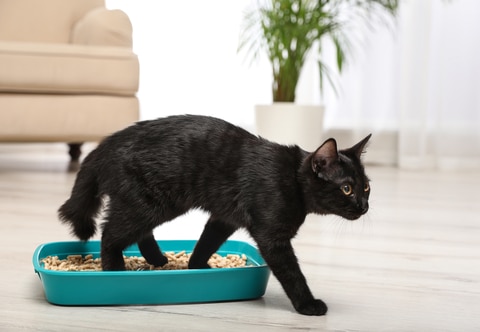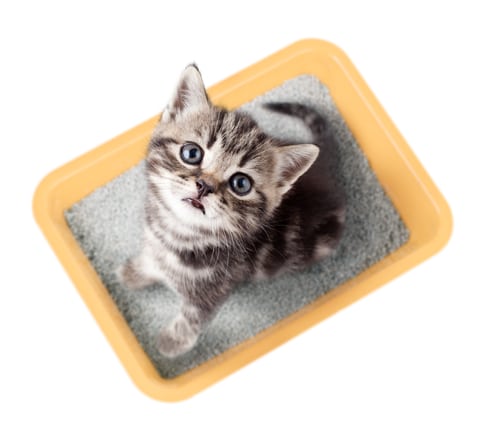

The Complete Guide to Cat Litter Box Training
Cat litter box training is one of the main concerns for every new cat owner. The following is a complete guide to helping you better understand the subject.
You’ve just gotten a new cat. As a new owner, though, you are probably wondering about litter training your new cat. Contrary to popular belief, cat litter box training is pretty simple. Many cats teach their kittens how to use litter boxes from an early age, while others instinctively do so.
Even though most cats and kittens quickly get used to using litter boxes, others may develop some issues. As a result, they might not use the box at all or use it for either urination or defecation.
We will cover the essentials of cat litter box training in this blog, as well as various reasons why your cat might not be using it properly.
1. Supplies Required for Cat Litter Box Training
1.1 Litter boxes

If you’re wondering how many litter boxes you should get, the rule of thumb is to have an extra litter box for one cat. So if you have one cat, you should ideally have two litter boxes at hand. Place the boxes in areas that offer sufficient privacy and are easily accessible for your cat. If the litter boxes are too exposed, your cat might not feel secured enough to turn to them.
1.2 Kitty litter

When it comes to kitty litter, there are numerous options out there. These may range from the inexpensive, non-clumping type to the eco-friendly options, which are made from recycled newspapers, pine pellets, and wheat. Although most cats do not really care about the kind of litter they use, some are extremely picky and might refuse to use litter if they dislike its smell or texture. To be on the safe side, always begin with an unscented litter, and then you can experiment with other types once the cat litter box training is complete.
1.3 Toys and Treats

Whenever you notice your kitten using the litter box, do not forget to reward her with her favorite cat food or any other treat. Using positive reinforcement is a great way to train her to use the litter box. For example, you can give her toys or praise her. However, you will also have to make sure that your cat does not start expecting a treat or gift every time she turns to the litter box.
Our ‘cat supply checklist‘ provides a list of essentials that every cat needs.
2. Cat Litter Box Training – The Process
Here are some essential cat litter box training steps that can help you to train your cat to use the litter box:
- Make sure that your cat knows all about the boxes from the moment she arrives at your house. Place your cat inside the box and allow her to examine and sniff it. However, do not make the mistake of removing the box once your cat becomes familiar with it, as this behavior might end up confusing her.
- Place the cat in a litter box after every meal and as soon as she completes her nap. Do the same if you notice that your cat needs to eliminate – for instance, if you see her crouching in or sniffing a specific area.
- Once again, be sure to compliment her or reward her every time she makes use of the litter box.
- Do not be strict and avoid scolding or punishing your cat in case of any accidents or mistakes. Such behavior will cause your cat to become more stressed and anxious, which will ultimately complicate the cat litter box training process. If you punish her, thinking that it would make her use the litter box next time, this isn’t true. In fact, your cat will be scared to use the litter box and will avoid using it altogether.
3. Maintenance and Cleaning
Make sure that the litter box is properly cared for. Alongside removing the terrible ‘cat smell,’ proper care will also make sure that your cat enjoys using the litter box. Here are some ways you can maintain and clean the litter box:
- Ensure daily scooping in order to get rid of the deposits. You will have to replace the soil whenever the litter is unable to keep the odor in check.
- When changing the litter, make sure to disinfect and clean the box. Use water and mild soap or a mixture containing white vinegar and water for this purpose. Avoid using commercial disinfectants or bleach as they contain harsh chemicals that may be detrimental to your cat’s health.
- If your kitten has had any accidents outside the litter box, use enzymes to clean those areas. Enzyme cleaners will get rid of the smell, thereby making sure that the smell does not discourage your cat from turning to those spots.
4. Reasons that Your Cat Might Not Use the Litter Box
There are several reasons why your cat may stop using the litter box, including the following:
4.1 Management problems
If the cat feels uncomfortable using the box or is unable to access it, she won’t use it. Below are a few common reasons behind your cat not using the litter box even after completing the cat litter box training:
- You are not cleaning the litter box thoroughly or frequently enough.
- Cats generally dislike sharing their litter box with other cats. If there are insufficient litter boxes in your house, you need to have one more litter box than the number of cats you have.
- The litter box is not big enough for your cat.
- Your cat is not able to access the box every time she needs to.
- Your cat dislikes the litter box or does not like where and how the litter box has been placed.
- The litter box contains a liner or hood that causes your cat discomfort or pain.
- The litter is placed too deep in the box. Usually, cats prefer around a couple of inches of litter.
4.2 Surface preferences
Certain cats would rather eliminate specific textures or surfaces in your households, such as bedding, potting soil, or carpets.
4.3 Preference towards certain litter
As is the case with night predators, cats’ high sensitivity to touch and smell allows them to effectively navigate their surroundings. However, these sensitivities may also play a key role in the way a cat reacts to the litter. Cats who are used to certain kinds of litter might not like the feel or smell of another litter.
4.4 Prefer or avoid specific locations
Much like dogs and humans, cats also have certain locations where they like to eliminate, and they often avoid other locations. So, if you have placed the litter box in a spot that your cat does not like, she might not use the box at all.
4.5 Being unable to use the box
If your cat is geriatric or has any other physical restrictions, she might not be able to use a litter box, especially litter boxes that have high sides or are top-entry.
4.6 Negative association with the litter box
If your cat had been using her litter box in the past, you might be surprised to see her suddenly starting to eliminate outside. A common reason for this change in behavior is an upsetting event happening while she was using the box. In such cases, cats might hesitate to go back to the litter box in question. Sometimes, a cat might go inside the litter box but immediately come out even without using it.
Painful elimination is a common cause for such negative associations. If a medical condition caused pain to your cat during elimination, your cat would start associating the pain with the litter box. Even after your cat becomes healthy, this association might force her to avoid the box.
4.7 Stress within the household
Stress is another major reason behind cats refusing to use litter boxes. For instance, certain events that might not be stressful to humans can end up traumatizing cats. Similarly, any changes in the cat’s environment, such as the addition of a new family member or animal, can heighten the cat’s anxiety. As a result, she might not use the litter box.
4.8 Cat conflict
If there are multiple cats in your household, one or a few of them can prevent the other cats from using the box. Even without a direct confrontation regarding the use of the litter box, a conflict can lead to stress among the cats and lead to litter box issues.
5. Medical Problems Leading to Your Cat Not Using the Litter Box

5.1 UTI (Urinary Tract Infection)
If you’ve noticed your cat entering the litter box more times than is normal and passing no or tiny amounts of urine amounts, she is probably suffering from a UTI. If you suspect this condition, you should take your cat to a veterinarian.
5.2 Interstitial Cystitis
Cystitis is another term for ‘inflamed bladder,’ and the feline version of interstitial cystitis is a neurological condition affecting cats. Cats struggling with cystitis might need to urinate more frequently and will even strain to produce urine, but without success. Cats with interstitial cystitis will often lick themselves during urination. Often, blood accompanies their urine. So, feline cystitis might cause your cat to avoid using her box, but only because of the pain and urgency associated with the urination. Feline cystitis needs to be addressed by a veterinarian.
5.3 Blockage or kidney stones
If your cat is dealing with a blockage or has stones in her kidney, you might notice her frequently making her way into the box. Also, the pain during elimination might cause your cat to cry or meow. Moreover, her abdomen might become sensitive to touch.
6. Behavioral Issues to Rule Out for Cat Litter Box Training
The problem of urine marking is a very common one because it requires urinating outside of a litter box and almost all pet owners consider it to be a litter box problem. Because the reason and the remedy are quite different from what we normally encounter in litter boxes, we rule out urine mark problems.
Cats that mark their urine will often use the litter box, but will also eliminate urine in other places, usually vertically. Cats mark by leaning against a vertical surface or object, such as a speaker, wall, or the side of a chair, and erecting their bodies and straightening their tails. The cat will then proceed to spray urine all over the surface, during which her tail may twitch. In urine marking, a cat deposits less urine than she would in her litter box.
7. Tips for Cats that Do Not Use the Litter Box
If your cat does not use her litter box, even after you have dedicated sufficient time to cat litter box training, there are a few more things you can do to help her:
Tips
- Every cat prefers a clean litter box, which is why you should clean and scoop on a daily basis. Every week, use unscented soap or baking soda and rinse the box.
- With a few exceptions, cats like large and spacey litter boxes that are easily enterable. You can use storage containers as litter boxes.
- Your cat likely prefers shallow litter beds. Avoid overdoing the litter and provide no more than a couple of inches.
- Cats prefer litter that is unscented and clumping.
- If your cat used a certain type of litter when she was a kitten, she might still want that particular type.
- Cats usually dislike any lids or liners on their litter boxes.
- Make sure that your cat’s litter box is placed in a location that is quiet but not quite cornered. Even though cats want privacy, they want to be able to notice people or animals going to and from. Also, cats detest being cornered and always prefer having several escape routes should they want to exit the litter box quickly.
- A self-cleaning box is generally cleaner than its conventional counterpart, cats like such boxes better. However, if you use a self-cleaning box and find your cat eliminating outside, you should go back to conventional litter boxes.
8. Ways to Resolve a Litter Box Issue
If your cat avoids using the litter box, you should start by ruling out any medical condition or urine marking. Visit a veterinarian and have them perform a thorough examination of the cat. Once you are satisfied that your cat does not have a medical problem, here are a few things that you can try out:
- Have sufficient litter boxes – remember: a box more than the number of cats in your household.
- Place the boxes in locations that are not high-traffic areas and where your cat will not feel cornered or trapped. For cat owners residing in multistory residences, it is a good idea to put a box on every level. Do not put the boxes in intimidating or loud places, such as close to the dryer or washer or where your dog’s water or food is placed. Also, avoid using areas that get a great deal of foot traffic.
- Make sure that the food bowl is NOT next to the litter box.
- Get rid of any liners or covers.
- Use different litter types for the boxes to offer options to your cat. A cat usually prefers the clumping type of litter having a fine or medium texture. Also, utilize unscented litter. Place all the boxes side-by-side so that your cat can pick the one she prefers the most.
- Make scooping a part of your daily schedule. Every week, clean all the boxes using unscented soap and warm water or baking soda without any soap and change the litter. If you use scented cleaners, there is a chance that your cat might dislike the scent.
- If your cat had had an accident, clean the box thoroughly using an enzymatic cleaner that will neutralize the pet odor. These cleaners are easily available at pet stores.
- If you find your cat soiling a mere few spots, you should probably place boxes there. If the spot is one where you are unable to place a litter box, putting the cat’s food or water bowl close to that area will discourage elimination.
- You should take steps to ensure that any inappropriate elimination spots are not appealing to your cat. Make sure to install either motion-activated or regular lights in any dark regions. Placing sticky tape, tin foil, or carpet runners can make it difficult or unpleasant for your cat to stand.
9. Resolving Household Stress
Stress and anxiety can cause cats to avoid using their litter boxes. Hence, you need to ensure that you are keeping your cat’s environment free of any stressors. You should keep things as consistent as possible. This means always keeping your cat’s bowl in the same place and maintaining a predictable routine for her. If you own any dogs, you should keep them from chasing the cat. Sometimes, seeing outdoor cats can also upset your pet cat, so make sure to keep your doors and windows shut. Using diffusers or sprays with synthetic pheromones – like the one’s cat emits when they want to mate with another cat – can help relieve stress in your feline friend.
10. What if The Cat is Unable to Use the Box?
Keep in mind, there are certain types of cats that are unable to use litter boxes. These include geriatric cats, arthritic cats, aged cats, or cats that are extremely young. If you have such a cat, avoid placing litter boxes that have very high sides or contain top-side openings that make it harder for a cat to enter and leave. Instead, make use of boxes that have lower sides.
11. Things to Avoid While Solving Litter Box Problems
Regardless of the steps, you take in order to resolve your kitty’s elimination issues, here are some things that you should absolutely not do:
- Rub the cat’s nose in her feces or urine.
- Drag your cat to her litter box, or scold her for not using the box.
- Restrict your cat to a small room that contains the litter box (this strategy can help if it is being complemented by other strategies or steps).
- Use ammonia cleaners to clean up any accidents. Ammonia is one of the contents of urine, and if you use it for cleaning purposes, your cat will simply be attracted to the same spot the next time she wants to urinate. You should instead use products that have been specifically designed for pet accidents.
12. Cat Litter Box Training for Older Cats
If you have an older cat, you might expect that it has had its cat litter box training in the past and will be able to implement its learning. However, if your cat was previously an outdoor one, it might pose a training challenge for you. Even then, a cat is normally equipped with every instinct needed to learn about a litter box and its purpose. The challenge is actually getting her accustomed to the box. In this case, a good idea would be to fill the box with outdoor soil at the beginning. Once your cat adapts and starts using the box, you should gradually start using litter to replace the soil so that the cat can familiarize herself with the different surface.
13. Final Word
We hope that this comprehensive guide on cat litter box training will help you maintain a healthy and happy relationship with your furry friend. In most cases, cat litter box training is pretty easy and quick, but even if you run into trouble, the contents of this guide will have you covered.
Discover how to create a joyful, healthy home for your pet.
Subscribe to your weekly rundown of practice, real life ideas and training tips straight to your inbox.


